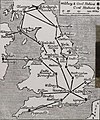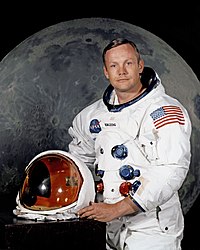Portal:Aviation
| Main page | Categories & Main topics |
|
Tasks and Projects |
The Aviation Portal

Aviation includes the activities surrounding mechanical flight and the aircraft industry. Aircraft includes fixed-wing and rotary-wing types, morphable wings, wing-less lifting bodies, as well as lighter-than-air craft such as hot air balloons and airships.
Aviation began in the 18th century with the development of the hot air balloon, an apparatus capable of atmospheric displacement through buoyancy. Some of the most significant advancements in aviation technology came with the controlled gliding flying of Otto Lilienthal in 1896; then a large step in significance came with the construction of the first powered airplane by the Wright brothers in the early 1900s. Since that time, aviation has been technologically revolutionized by the introduction of the jet which permitted a major form of transport throughout the world. (Full article...)
Selected article
A hot air balloon consists of a bag called the envelope that is capable of containing heated air. Suspended beneath is the gondola or wicker basket (in some long-distance or high-altitude balloons, a capsule) which carries the passengers and a source of heat. The heated air inside the envelope makes it buoyant since it has a lower density than the relatively cold air outside the envelope. Unlike gas balloons, the envelope does not have to be sealed at the bottom since the air near the bottom of the envelope is at the same pressure as the surrounding air. In today's sport balloons the envelope is generally made from nylon fabric and the mouth of the balloon (closest to the burner flame) is made from fire resistant material such as Nomex.
Recently, balloon envelopes have been made in all kinds of shapes, such as hot dogs, rocket ships, and the shapes of commercial products. Hot air balloons that can be propelled through the air rather than just being pushed along by the wind are known as airships or, more specifically, thermal airships. (Full article...)
Selected image
Did you know
...that the pioneer American airman Lowell Smith participated in the first mid-air refueling, the first aerial circumnavigation and held 16 records for military aircraft in speed, endurance and distance? ...that the Blohm und Voss Bv 144 was an attempt by Nazi Germany to develop an advanced commercial airliner for post-war service? ...that the Silver Centenary biplane, built in Beverley, Western Australia in 1930, received its airworthiness certificate 77 years after its first flight?
General images -
In the news
- May 29: Austrian Airlines cancels Moscow-bound flight after Russia refuses a reroute outside Belarusian airspace
- August 8: Passenger flight crashes upon landing at Calicut airport in India
- June 4: Power firm helicopter strikes cables, crashes near Fairfield, California
- January 29: Former basketball player Kobe Bryant dies in helicopter crash, aged 41
- January 13: Iran admits downing Ukrainian jet, cites 'human error'
- January 10: Fire erupts in parking structure at Sola Airport, Norway
- October 27: US announces restrictions on flying to Cuba
- October 3: World War II era plane crashes in Connecticut, US, killing at least seven
- September 10: Nevada prop plane crash near Las Vegas leaves two dead, three injured
- August 6: French inventor Franky Zapata successfully crosses English Channel on jet-powered hoverboard
Related portals
Associated Wikimedia
The following Wikimedia Foundation sister projects provide more on this subject:
-
Commons
Free media repository -
Wikibooks
Free textbooks and manuals -
Wikidata
Free knowledge base -
Wikinews
Free-content news -
Wikiquote
Collection of quotations -
Wikisource
Free-content library -
Wikiversity
Free learning tools -
Wikivoyage
Free travel guide -
Wiktionary
Dictionary and thesaurus
Selected biography
Before becoming an astronaut, Armstrong was in the United States Navy and saw action in the Korean War. After the war, he served as a test pilot at the National Advisory Committee for Aeronautics (NACA) High-Speed Flight Station, now known as the Dryden Flight Research Center, where he flew over 900 flights in a variety of aircraft. As a research pilot, Armstrong served as project pilot on the F-100 Super Sabre A and C aircraft, F-101 Voodoo, and the Lockheed F-104A Starfighter. He also flew the Bell X-1B, Bell X-5, North American X-15, F-105 Thunderchief, F-106 Delta Dart, B-47 Stratojet, KC-135 Stratotanker and Paresev. He graduated from Purdue University.
Selected Aircraft

The Pregnant Guppy was a large, wide-bodied cargo aircraft built in the USA and used for ferrying outsized cargo items, most notably NASA's components of the Apollo moon program. The Pregnant Guppy was the first of the Guppy line of aircraft produced by Aero Spacelines, Inc. The design also inspired similar designs such as the jet-powered Airbus Beluga, and the Boeing 747 LCF designed to deliver Boeing 787 parts.
Today in Aviation
- 2010 – A USAF Lockheed Martin F-22A Raptor, 06-4125, of the 525th Fighter Squadron, 3d Wing, crashes in Alaska near Susitna Lodge, killing pilot Capt. Jeffrey Haney, from Clarklake, Michigan.
- 2009 – Launch: Space Shuttle Atlantis STS-129 at 19:28:09 UTCT. Mission highlights: ISS assembly flight ULF3: ExPRESS Logistics Carriers (ELCs) 1 & 2.
- 2007 – Inclement weather caused a BHP Billiton AS350-B2 helicopter,[1] to crash in Angola, killing the helicopter's five passengers.[2]
- 1984 – Landed: Space Shuttle Discovery STS-51-A at 11:59:56 UTC KSC, Runway 15. Mission highlights: Multiple comsat deployments, retrieval of two other comsats Palapa B2 and Westar VI which were subsequently refurbished on Earth and reflown.
- 1982 – Landing: Space shuttle Columbia STS-5 at 14:33:26 UTC. Mission highlights: Multiple comsat deployments. First EVA of program canceled due to suit problems.
- 1973 – Skylab 4 launches into orbit as the fourth Skylab mission, bringing the third and final crew to the space station.
- 1973 – While on reserve station south of Crete, a U.S. Marine Corps Boeing-Vertol CH-46 Sea Knight from USS Guadalcanal (LPH-7) loses engine power during a routine flight while hovering above the USS Barry. The helicopter, with crewmen aboard, crashes into the destroyer's ASROC deck, rolls over the starboard side, and almost immediately sinks. While no one on Barry was injured, only two of the three helicopter crew were rescued by the ship's Motor Whale Boat.
- 1970 – First flight of the Lockheed L-1011 TriStar
- 1970 – A U.S. Navy McDonnell Douglas F-4 Phantom II crashed in the Atlantic Ocean 30 miles E of the Virginia Capes shortly after launch from the carrier USS Forrestal, CVA-59. Two crew, out of NAS Oceana, Virginia, are lost, the Navy reported 17 November. Pilot was Lt.j.g. John Dale O'Connor, and RSO was Lt.j.g. Thomas F. Hanagan, both of Virginia Beach, Virginia. They were attached to a fighter squadron based at NAS Oceana at Virginia Beach.
- 1967 – American aircraft attack the shipyards at Haiphong, North Vietnam, for the first time.
- 1965 – Russia’s Venera 3, the first spacecraft to land on another planet’s surface, is launched.
- 1959 – First flight of the Canadair CL-44
- 1959 – National Airlines Flight 967, a Douglas DC-7 B, crashes into the Gulf of Mexico while on a flight from Tampa, Florida to New Orleans, Louisiana, in a possible case of sabotage; all 40 on board perish.
- 1955 – KLM places an order for eight DC-8 s.
- 1953 – First trans-Canada flight by a CF-100 Canuck aircraft from RCAF 445 Squadron took place.
- 1946 – First flight of the Saab 90 Scandia
- 1945 – Pan American World Airways resumes commercial seaplane service between California and Hawaii, using Boeing Clipper aircraft it has leased to the U.S. Navy during World War II.
- 1942 – A B-24D Liberator of the 1st Antisubmarine Squadron based at St. Eval in the United Kingdom flies the first operational mission of the U.S. Army Air Forces Antisubmarine Command.
- 1938 – HMS Ark Royal enters service with the Royal Navy as the world’s first aircraft carrier with deck armor.
- 1937 – A Sabena Junkers Ju 52 crashes near Ostend, Belgium, killing all 11 on board, including the Grand Duke Georg Donatus and Grand Duchess Cecilie of Hesse, who was eight months pregnant.
- 1928 – Western Canada Airways established the Prairie Air Mail Route, an experimental air ail service operated for 20 days.
- 1927 – The United States Navy commissions USS Saratoga (CV-3), its first large aircraft carrier and its first carrier capable of fleet speeds and true combat operations.
- 1920 – QANTAS is formed at Longreach, Queensland.
- 1919 – Cpt Henry Wrigley and Lt Arthur Murphy make the first aerial crossing of Australia, flying a Royal Aircraft Factory BE.2e from Melbourne to Darwin, taking 46 hours
- 1915 – Victor Carlstrom became the first pilot to fly from Toronto to New York. Carlstrom flew in a Curtiss R-2 biplane and was in the air for 6 hours and 40 min.
- 1909 – German Count Ferdinand von Zeppelin forms the world’s first commercial airline, DELAG [Deutsche Luftschiffahrts-Aktiengesellschaft (German for "German Airship Travel Corporation")]
- 1906 – First flight of the Lebaudy Patrie, French semi-rigid airship.
References
- ^ "5 die in Angola chopper crash". News24, 18 November 2007. Retrieved 22 October 2012.
- ^ Angela Macdonald-Smith (2007). "BHP Suspends Operations in Angola After Fatal Helicopter Crash". Bloomberg. Retrieved 2012-10-22.
- Shortcuts to this page: Portal:Airplanes • P:AVIA






















































